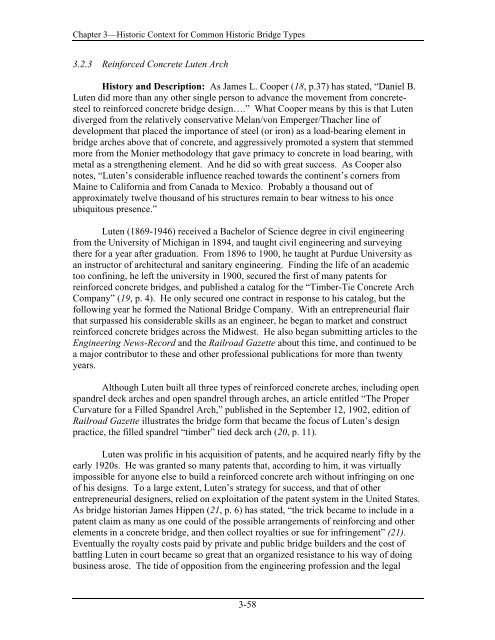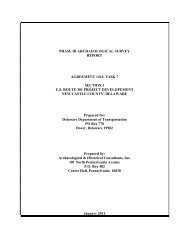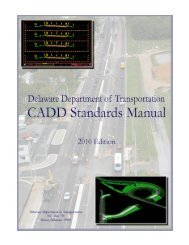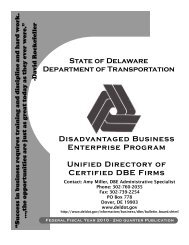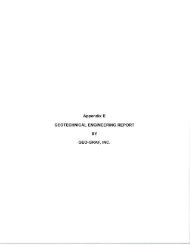Gulph Creek Stone Arch Bridge - Delaware Department of ...
Gulph Creek Stone Arch Bridge - Delaware Department of ...
Gulph Creek Stone Arch Bridge - Delaware Department of ...
You also want an ePaper? Increase the reach of your titles
YUMPU automatically turns print PDFs into web optimized ePapers that Google loves.
Chapter 3—Historic Context for Common Historic <strong>Bridge</strong> Types<br />
3.2.3 Reinforced Concrete Luten <strong>Arch</strong><br />
History and Description: As James L. Cooper (18, p.37) has stated, “Daniel B.<br />
Luten did more than any other single person to advance the movement from concretesteel<br />
to reinforced concrete bridge design….” What Cooper means by this is that Luten<br />
diverged from the relatively conservative Melan/von Emperger/Thacher line <strong>of</strong><br />
development that placed the importance <strong>of</strong> steel (or iron) as a load-bearing element in<br />
bridge arches above that <strong>of</strong> concrete, and aggressively promoted a system that stemmed<br />
more from the Monier methodology that gave primacy to concrete in load bearing, with<br />
metal as a strengthening element. And he did so with great success. As Cooper also<br />
notes, “Luten’s considerable influence reached towards the continent’s corners from<br />
Maine to California and from Canada to Mexico. Probably a thousand out <strong>of</strong><br />
approximately twelve thousand <strong>of</strong> his structures remain to bear witness to his once<br />
ubiquitous presence.”<br />
Luten (1869-1946) received a Bachelor <strong>of</strong> Science degree in civil engineering<br />
from the University <strong>of</strong> Michigan in 1894, and taught civil engineering and surveying<br />
there for a year after graduation. From 1896 to 1900, he taught at Purdue University as<br />
an instructor <strong>of</strong> architectural and sanitary engineering. Finding the life <strong>of</strong> an academic<br />
too confining, he left the university in 1900, secured the first <strong>of</strong> many patents for<br />
reinforced concrete bridges, and published a catalog for the “Timber-Tie Concrete <strong>Arch</strong><br />
Company” (19, p. 4). He only secured one contract in response to his catalog, but the<br />
following year he formed the National <strong>Bridge</strong> Company. With an entrepreneurial flair<br />
that surpassed his considerable skills as an engineer, he began to market and construct<br />
reinforced concrete bridges across the Midwest. He also began submitting articles to the<br />
Engineering News-Record and the Railroad Gazette about this time, and continued to be<br />
a major contributor to these and other pr<strong>of</strong>essional publications for more than twenty<br />
years.<br />
Although Luten built all three types <strong>of</strong> reinforced concrete arches, including open<br />
spandrel deck arches and open spandrel through arches, an article entitled “The Proper<br />
Curvature for a Filled Spandrel <strong>Arch</strong>,” published in the September 12, 1902, edition <strong>of</strong><br />
Railroad Gazette illustrates the bridge form that became the focus <strong>of</strong> Luten’s design<br />
practice, the filled spandrel “timber” tied deck arch (20, p. 11).<br />
Luten was prolific in his acquisition <strong>of</strong> patents, and he acquired nearly fifty by the<br />
early 1920s. He was granted so many patents that, according to him, it was virtually<br />
impossible for anyone else to build a reinforced concrete arch without infringing on one<br />
<strong>of</strong> his designs. To a large extent, Luten’s strategy for success, and that <strong>of</strong> other<br />
entrepreneurial designers, relied on exploitation <strong>of</strong> the patent system in the United States.<br />
As bridge historian James Hippen (21, p. 6) has stated, “the trick became to include in a<br />
patent claim as many as one could <strong>of</strong> the possible arrangements <strong>of</strong> reinforcing and other<br />
elements in a concrete bridge, and then collect royalties or sue for infringement” (21).<br />
Eventually the royalty costs paid by private and public bridge builders and the cost <strong>of</strong><br />
battling Luten in court became so great that an organized resistance to his way <strong>of</strong> doing<br />
business arose. The tide <strong>of</strong> opposition from the engineering pr<strong>of</strong>ession and the legal<br />
3-58


